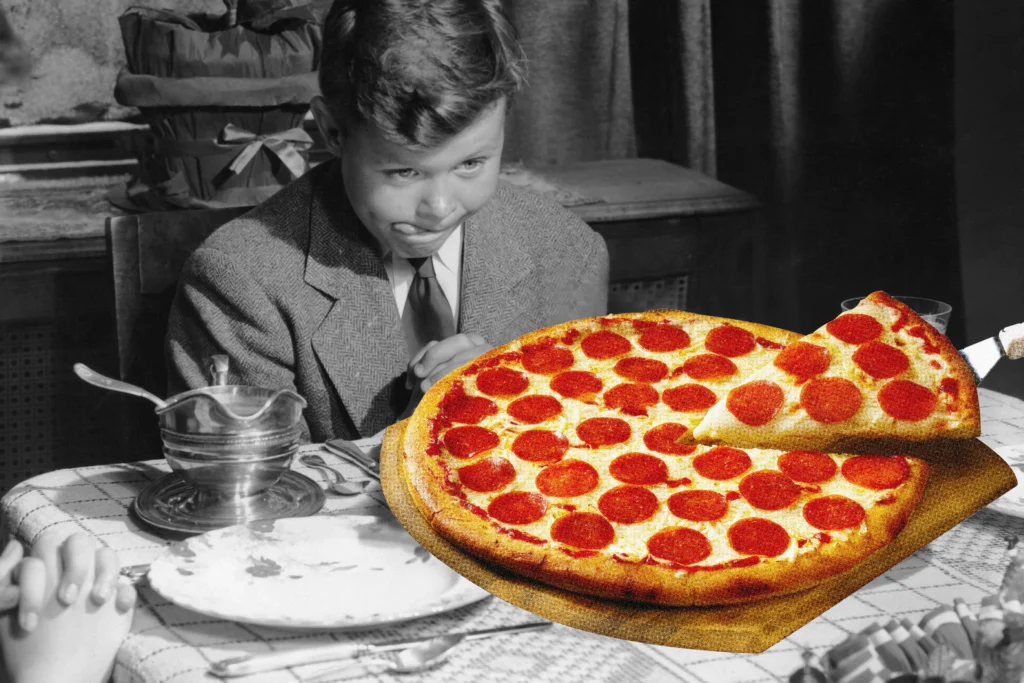
Do you have kids? Do you want them to say more than two words at dinner? I have figured out (by reading about and studying linguistics and communication) ways to get a child talking (a lot!) during dinner. Here, I share my five brilliant conversation starters.
The whole concept of family dinner, if you think about it, is pretty elemental: you gather around a table in the waning hours, you and yours, and eat, converse about your day and, if you’re lucky, life itself. But sometimes — or, most of the time — our dinners can resemble not so much a family eating in the kitchen of our Dutch colonial but a pre-verbal gathering of primitive hominids on the veldt, hunched over a large rock, devouring the day’s kill with frightening, brutal efficiency — quick, before somebody steals it! — and doing it all through a silence punctured only by occasional lip smacks and grunts of pleasure. In other words, getting dinner on the table often feels like the easy part; it’s the conversing and communicating — the family part of family dinner — that often prove more elusive. And, okay, if you insist on greater specificity, it’s my ability to get my child to SPEAK TO ME that is often very much in doubt.
Does this exchange sound familiar to you?
“What’d you do today?”
“What?”
“What’d you do today?
“Huh?”
“What’d you do today?”
“Mmm, I don’t remember.”
“What’d you do today?”
“I need ketchup.”
Over the past few years, I’ve devised a few techniques to deal with this situation, ways to prod and cajole Joel into sharing and prompting and interacting — or, at the barest minimum, stopping for a moment to look up and acknowledge something beyond the food on his plates…
Mad-Sad-Glad
The most consistently successful of all my methods. Each person at the table has to share one thing from their day that made them mad, one thing that made them sad, and one thing that made them glad. In addition to initiating some real conversation (we rarely make it all the way around the table, once everyone gets going) this has the welcome benefit of clueing you into some things in your kids’ lives — anxieties, accomplishments, mean girls at camp, math difficulties, and the always-telling lunch table politics — that they might otherwise have locked away in a drawer and let fester.
The Negative Assertion
This doesn’t deliver the kind of sustained, substantive conversation you get with Mad Sad Glad, but it often helps break the ice and get some dinnertime energy flowing. Kids love to prove their parents wrong — or, at least, my kid loves to prove me wrong — so I’ll offer up an observation that I know is untrue, and wait for the kids to set the record straight. Like this one, from a beautiful, clear summer evening last year:
Me: “I can’t believe you had to stay inside all day at camp today because of the weather.”
Abby: “No we didn’t!”
Me: “Man, that must have been so boring.”
Phoebe: “We were outside all day! We hiked down to the river, and had lunch under the poison ivy tree, and…”
Other options: Why do you think Mrs. H. decided to skip math lessons today? I can’t believe nobody said a word on the bus on the way home this afternoon. Do you guys ever wonder how an ostrich flies? So a friend tells me you hate playing Playstation now…
Talk About Yourself (And Let Them Jump In)
My own life doesn’t always strike me as riveting, but you’d be surprised at what kids get into. An example: a year or so ago, I was working on an article about moving from Canada to Austria and studying full-time at Carleton University in Ottawa. How hard the winters in Canada were and such things. My son couldn’t get enough! He still asks me from time to time on how life was in Canada when he was still so small. The snowstorms and the Powwow Festivals. Seriously. Possible moral of story: we’re not as boring as we think we are?
The Misdirection Play
I hardly ever get an answer when I ask my kid something directly. (“What did you do at school today?”) Similar to the Negative Assertion approach, I find it helps to take the pressure off a little by asking to tell a story about someone else. But maybe don’t phrase it quite so overtly. Phrase it like this: “So [your kid’s name here], tell me about this new friend of yours, [new friend name here]. Does she have long hair? Does she like watching Young Sheldon? At recess, is she a cop or a robber?” Bet you anything your kid responds, and when he/she does, you’ve got them right where you want them. You can take the conversation anywhere from there.
The Awkward Silence
Join forces with your partner and resolve to say nothing, not a word. Kids can’t hack it. They fill the silence. (Only downside: my son fills it by saying, “Herpoooooooooouuuuuuuuu – don’t ask why or what this even means.”)
The Nuclear Option
To be deployed only in truly desperate situations: “Okay, if you don’t start telling me about your days, we’re not having chocoloate tonight.” This one has never failed — and believe me, I’ve wielded it way more than I should ever admit.
Thank you so much for reading my blog! What do you guys think? Any other tips you have for starting conversations with little dudes? Are your kids chatty at dinner?